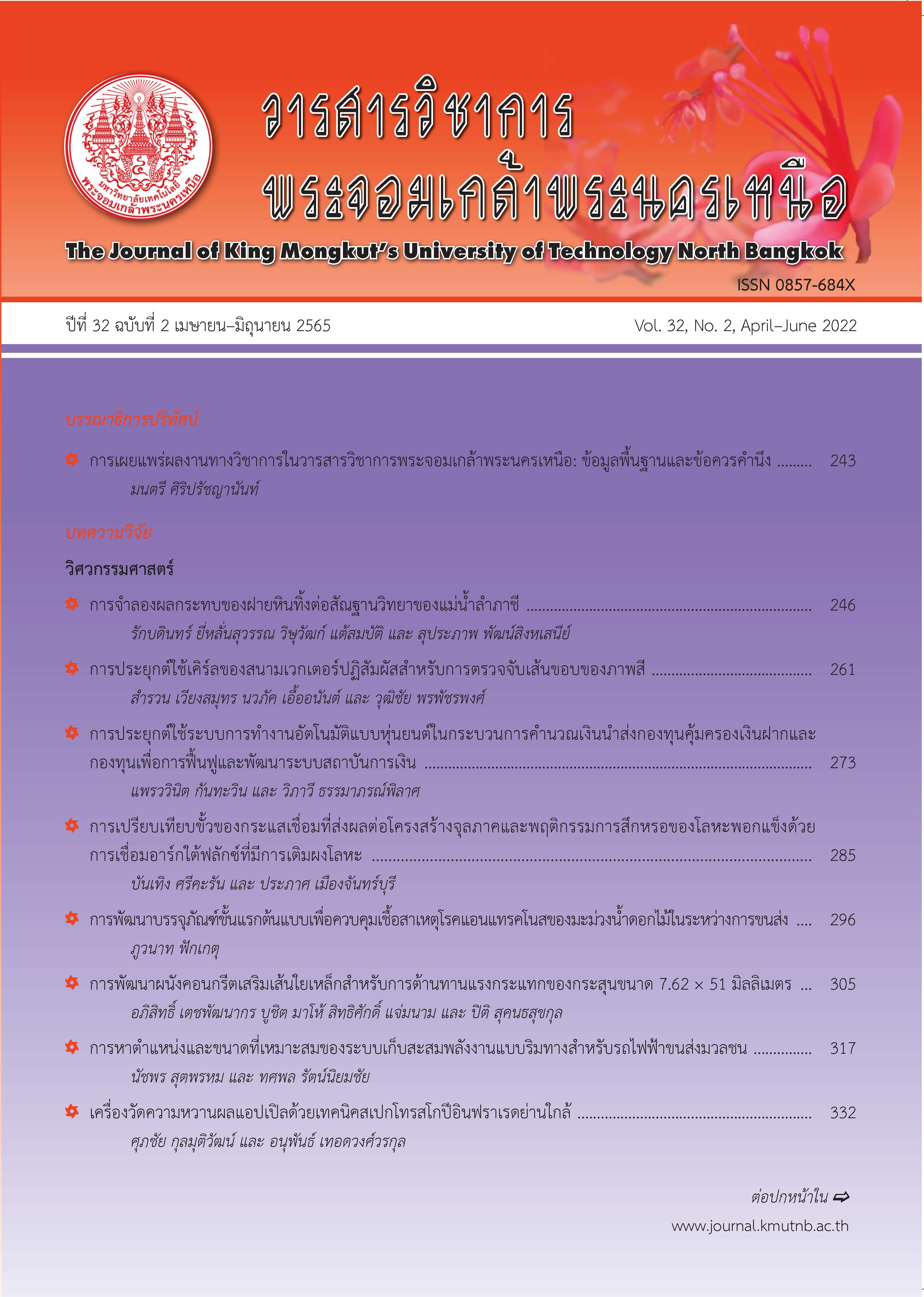A Device for Measuring Apple Sweetness Using Near Infrared Spectroscopy
Main Article Content
Abstract
This research developed an apple sweetness measuring device without damaging the apple fruit by near-infrared absorbance measured in reflectance mode. The portable device was 23.6 cm wide, 35 cm long and 25 cm high. It consisted of a sample holder box, light source, spectrometer, reflectance carrying fiber optic, and controlling computer. In the development of the sweetness evaluation equation for coding in the controlling program, one hundred apples of Fuji cultivar were measured for near-infrared (NIR) absorbance in a wavelength range of 900 to 1700 nm and sweetness in terms of soluble solids content, which were used to develop the sweetness evaluating equation by partial least squares regression analysis. The performance of the equation for sweetness evaluation was achieved with a correlation coefficient (r) of 0.81 and root mean square error of prediction (RMSEP) of 0.69 °Brix. For testing the accuracy of the sweetness measuring device, the regression coefficients of the evaluation equation were coded as a part of the controlling program for sweetness evaluation. Apples purchased at a different time from those used in the equation development were tested by measuring the NIR absorbance on the device. The sweetness evaluation performance, comparing the evaluated sweetness and the reference sweetness showed accuracy with RMSEP of 0.75 °Brix. The sweetness measuring device based on NIR absorbance could be used to evaluate the sweetness of apple and show the sweetness result within 5 seconds.
Article Details

This work is licensed under a Creative Commons Attribution-NonCommercial-NoDerivatives 4.0 International License.
The articles published are the opinion of the author only. The author is responsible for any legal consequences. That may arise from that article.
References
Medthai. (2020, July 19). Apple 19 Items of Properties and Benefits of Apples. [Online]. Available: https://medthai.com/แอปเปิล.
V. Cortés, J. Blasco, N. Aleixos, S. Cubero, and P. Talens, “Monitoring strategies for quality control of agricultural products using visible and near-infrared spectroscopy: A review,” Trends in Food Science & Technology, vol. 85, pp. 138–148, 2019.
R. K. Cho, M. R. Sohn, and Y. K. Kwon, “New observation of nondestructive evaluation for sweetness in apple fruit using near infrared spectroscopy,” Journal of Near Infrared Spectroscopy, vol. 6(A), pp. A75-A78, 1998.
M. Ventura, A. Jager, H. Putter, and F. P. M. M. Roelofs, “Nondestructive determination of soluble solids in apple fruit by near infrared spectroscopy,” Postharvest Biology and Technology, vol. 14, no. 1. pp. 21–27, 1998.
R. Lu and D. Ariana, “A Near Infrared sensing technique for measuring internal quality of apple fruit,” Applied Engineering in Agriculture, vol. 18, no 5. pp. 585–590, 2002.
S. Saranwong, J. Sornsrivichai, and S. Kawano, “Predictions of ripen stage quality of apple fruit from its harvest quality measured nondestructively by near infrared spectroscopy,” Postharvest Biology and Technology, vol. 31, no. 2, pp. 137–145, 2004.
S. N. Jha and R. Garg, “Non-destructive prediction of quality of intact apple using near infrared spectroscopy,” Journal of Food Science and Technology, vol. 47, no. 2, pp. 207–213, 2010.
Z. Guo, M. Wang, A. A. Agyekum, J. Wu, Q. Chen, M. Zuo, H. R. El-Seedi, F. Tao, J. Shi, Q. Ouyang, and X. Zou, “Quantitative detection of apple watercore and soluble solids content by near infrared transmittance spectroscopy,” Journal of Food Engineering, vol. 279, pp. 109955, 2020.
C. A. T. Dos Santos, M. Lopo, R. N. Páscoa, and J. A. Lopes, “A review on the applications of portable near-infrared spectrometers in the agro-food industry,” Applied Spectroscopy, vol. 67, no. 11, pp. 1215–1233, 2013.
Y. B. Ying, X. Fu, and H. Lu, ”Experiments on predicting sugar content in apples by FT-NIR technique,” Journal of Food Engineering, vol. 80, no. 3, pp. 986–989, 2007.
S. Fan, Q. Wang, X. Tian, G. Yang, Y. Xia, J. Li, and W. Huang, “Non-destructive evaluation of soluble solids content of apples using a developed portable Vis/NIR device,” Biosystems Engineering, vol. 193, pp. 138–148, 2020.
Y. Ying and Y. Liu, “Nondestructive measurement of internal quality in pear using genetic algorithms and FT-NIR spectroscopy,” Journal of Food Engineering, vol. 84, no. 2, pp. 206–213, 2008.
L. K. Sørensen and S. Dalsgaard, “Determination of clay and other soil properties by near infrared spectroscopy,” Soil Science Society of America Journal, vol. 69, no. 1, pp. 159–167, 2005.
N. M. Faber and R. Rajko, “How to avoid over-fitting in multivariate calibration—The conventional validation approach and an alternative,” Analytica Chimica Acta, vol. 595, no. (1–2), pp. 98–106, 2007.
K. Włodarska, I. Khmelinskii, and E. Sikorska, “Evaluation of quality parameters of apple juices using near-infrared spectroscopy and chemometrics,” Journal of Spectroscopy, pp. 1–8, 2018.
K. Sakulnarmrat and P. Jannok, “Study of the spectroscopic data analysis pretreatments for enhancing performance of NIR calibration model for determining the brix value of Japanese pear,” Naresuan University Journal: Science and Technology (NUJST), vol. 25, pp. 32–40, 2017 (in Thai).
Jr. J. Workman and L. Weyer, Practical Guide and Spectral Atlas for Interpretive Near-infrared Spectroscopy. CRC press, 2012, pp. 63. [18] P. Williams, (2007). Near-infrared Technology— Getting the Best out of Light Edition 5.0. Inc., Nanaimo, Canada, 2007, pp. 69–102.

